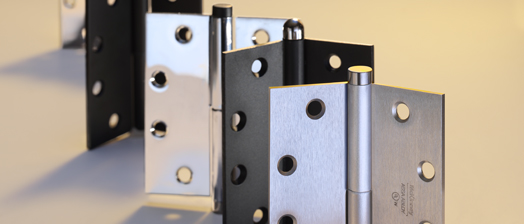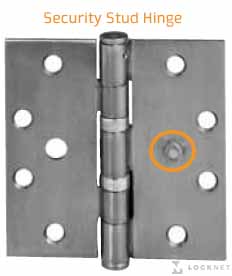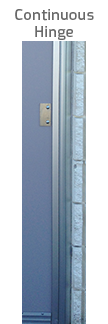 Door hinges are seemingly simple pieces of hardware that are often overlooked and brushed aside as unimportant. Think again, my friends. Hinges are actually quite important and can go a long way in either increasing or decreasing both the security and longevity of your doors.
Door hinges are seemingly simple pieces of hardware that are often overlooked and brushed aside as unimportant. Think again, my friends. Hinges are actually quite important and can go a long way in either increasing or decreasing both the security and longevity of your doors.
There are a few elements to consider when selecting the type of hinge you want to install:
- Are the hinges being installed on an exterior or secure door? If so, you should install a security hinge.
- Are the hinges being installed on a high-use or heavy door? If so, you need a heavy-duty grade 1 hinge.
Types of Hinges
There are two main types of hinges: butt hinges and continuous hinges.
A butt hinge is what you are probably most familiar with; you can find these hinges on virtually any residential door (and most commercial doors as well). The two leaves of the hinge are mated together with a pin. There are many different types of butt hinges, which we will talk about below.
Continuous hinges run the full length of a door and are typically used for exterior doors or heavy interior doors. Continuous hinges can either be pin and barrel or geared. Geared hinges are fairly self-explanatory – they link together by two gears that are enclosed in a casing.
Security Hinges
Remember when I asked you if you were installing hinges on an exterior or secure door? If you are, you definitely want at least one of the following security features on your hinge.
“But why, Katie?”
I’m so glad you asked! If you’re like most, you’ve been lucky enough to move oversized furniture. What do you do when that dang couch just won’t fit through the door? Remove the hinges, of course! It only takes a hammer, a screwdriver, and less than a minute. Check out this video on how to remove a door hinge – see what I mean? It’s incredibly simple.
Correct me if I’m wrong, but I don’t think you want it to be that easy for would-be criminals to get into your facilities. Hence, the need for security hinges.
There are three different types of security hinge features: continuous hinges, security studs, and non-removable pins.
Continuous Hinges
We touched on these earlier. They are considered security hinges because someone would have to cut the hinge the entire length of the door in order to remove the door from the opening. That would take a fair amount of time.
They also cover any gap between the door and the frame, leaving no room to pry the door on the hinge side.
Security Studs

Security studs are features on butt hinges that lock the two leaves of the hinge together when the door is closed. There is a stud on one leaf that mates into a hole on the other leaf.
This way, if the pin is removed or if the barrel is cut off of the hinge the two leaves are locked into each other. One would then have to pry the frame away from the door in order to be able to remove it from the opening.
Non-Removable Pins
Non-removable pins are another security feature on butt hinges. Again, the term is pretty self-explanatory. The pin cannot be removed from the barrel. In order to remove the door from the opening, the barrel would have to be cut off of the hinge.
Hardware Grade
We have preached about hardware grade before, and I’m about to preach about it again. This is because it is so important. Just like you don’t put cheap oil in a race car, you don’t put low-quality hardware on high-use doors. This includes your hinges.
If you are installing hinges on high-use or heavy doors, you really need to install a heavy-duty grade 1 hinge. This will hold up to the test of time and will help keep your door in alignment. If your door goes out of alignment, you will end up having issues with the locking hardware and closer, and will have a door that drags and is difficult to open. No bueno.
If you need help figuring out what type of hinge is best for your facility, drop us a note. We’re happy to help!



Thank you for sharing this information on door hinges. My wife and I just installed a security system in our home and this makes us feel a lot more comfortable. We also wanted to check out security hinges because I heard they are very nice. I never knew that the three security hinge features are called continuous hinges, security studs, and non-removable pins. I will have to call a professional to have them installed in my home. Thanks again!
So glad you enjoyed the post! Let us know if you have any more hinge questions!
I need to replace torn weatherstripping on the bottom of French doors with bal bearing NRP hinges. I removed the set screw but cannot figure out how to remove the pin from the barrel. Is the pin in an NRP hinge really totally non-removable, where I would need to remove the hinge from the door every time I need to replace the weatherstripping? The door is only 3-4 years old but out of warranty, and I can see having to do this periodically and don’t want to damage the wood each time I removed the screws in the door. Not sure who the hinge manufacturer is as there is no mark on the visible parts of the hinge.
Hi Jim-
Unfortunately in your case, the pin in NRP hinges is truly non-removable. You will need to remove the hinge from the door.
If you need to replace the weatherstripping that frequently, you may have other issues at hand. Have you checked the alignment of the door to ensure it is not dragging? Also, there are many forms of weatherstripping and door bottoms. You may want to look at alternate products to the one you are currently using if you have to replace it frequently. If you have more questions, give us a call and we can chat!
I need a source! I can not find what I need and it’s been weeks :-(.
I have a client that has two 8′ high double wood doors with 8 double panes (have 4 hinges on each door) and two 7′ high double wood doors with 6 panes (have 3 hinges on each door) all swing out to the outside in a downtown area. So I need 28 of total.
The current hinges are:
Full mortise, 4×4 inch, 5-knuckle 5/8 inch radius curve standard sleeves style. Currently painted…. they have removable pins, no security stud and are internal residential quality facing outside :-(. They are starting to corroding on the inside even under an overhang (but this is AZ so not too badly) . It’s amazing they have not been broken into in 10-years since install.
The best I’ve found so far including online searching, local big box retail & their “pro desks”, etc. I won’t mention names or brands:
1. Butt hinge, 4×4, full mortise, 5-knuckle, square corners (no radius), esidential, NRP & security stud. Brushed bronze. (in stock no less.. and 3/$10).
2. One other option is a ball bearing 4.5×4.5 but has no security features.
What I’d like as replacements (I need 28) Best Case: Commercial grade 1 or light commercial grade 2, ball bearing, butt hinge, 4×4 (or even 4.5), full mortise, 5-knuckle, 5/8″ radius, NRP & security stud. Brushed bronze or brown… (and NOT a spring loaded hinge (see below).
Any ideas? Sources?
(Two fun notes: on top of the wrong hinges, 1. the door closer on each have been installed wrong all this time and not utilizing the swing/latch/back check because of the extreme angle… go figure) 2.And of course they didn’t paint the top or bottom of the door on install…soooo some warpage/swelling mostly during summer monsoon season)
Thanks so much if anyone can point me in the right direction!
Luke
Hi, Luke! McKinney has ¼” radius as a standard option. 4” x 4” hinges are available. You would need to specify NRP, SSF, and RC (1/4”). These would have to be custom ordered and are probably more expensive than realized. You can send an email to construction@locknet.com if you would like a quote from us with what finish you need and I can inquire about a larger radius as that seems to be an option.
Hi Whitney, I just had outswing French doors installed on an exterior wall. The doors came with security tabs on the hinges. I’m wondering if I should replace them with non-removable pin hinges to create a more secure door?
Hi, Christie!
If you mean security stud hinges, you’re fine. Both security stud hinges and non removable pins were designed to make exterior doors more secure so there’s no reason to switch one out for the other.
I hope this answers your question!
I have 6 back doors. Yup, you read correctly, 6. The butt hinges all have the pins facing out, without any type of security feature (no studs or non-removable pins). The security hinges I find at the hardware store do not match the hole patter on the existing ones, although they are close. Who would have thunk it. Unfortunately, the doors are not that new, but big and beautiful. So I don’t want to damage the doors, and I cannot drill new holes because they are so close to the old ones & would just rip out. So here is my question… can I convert a regular butt hinge into a security hinge? Thanks so much!
Hi, Ben! We would actually need more information in order to help you. If you can email me directly at whitneyf@locknet.com, I can get you in touch with the right person.
I am working on a commercial door with a continuous hinge and it has a cover over the hinge. The cover has a small set screw on the side of it, when I remove it I can just barely slide the cover up and down with a little help from a prybar. I was looking online and saw some sites that said if you have a cover on one of these you really can’t remove it, you will need to cut it off. Do you have any knowledge of this style hinge and if so any ideas on removing the covers without destroying them in the process. The cover I am referencing is the cover that covers the hinges that attach to the door. There is a separate cover that is maybe 3/4 inch square that covers the screws that attach the hinge to the frame.
Appreciate any help on this as I am new to working with this style of hinge.
Hi, Ben! I think I may have instructions that can help with removing the hinge but would need your email address in order to send them to you. If you can email me directly at whitneyf@locknet.com I’d be more than happy to help!
I’m installing expensive wood exterior radius double door on new construction. My contractor is concerned about theft of the doors. What device can I use to lock the pins in the hinges?
The doors are inswing but the other doors to the home are generally not locked to allow for subs to come and go as they need to.
Thank you
Dan
Dan,
I suggest you use NRP (non removable pin) hinges. These hinges have a set screw that once tighten, prevents the hinge pins from being removed. It may also be a good idea to use hinge pin screws. These specialty screws have elongated heads that interlock the door and frame together when the door is closed. The heads of the screws act much the same way a deadbolt does. These are available from a variety of companies and can be found in locksmith shops that do door work.
All the best to you.
Ian Greene